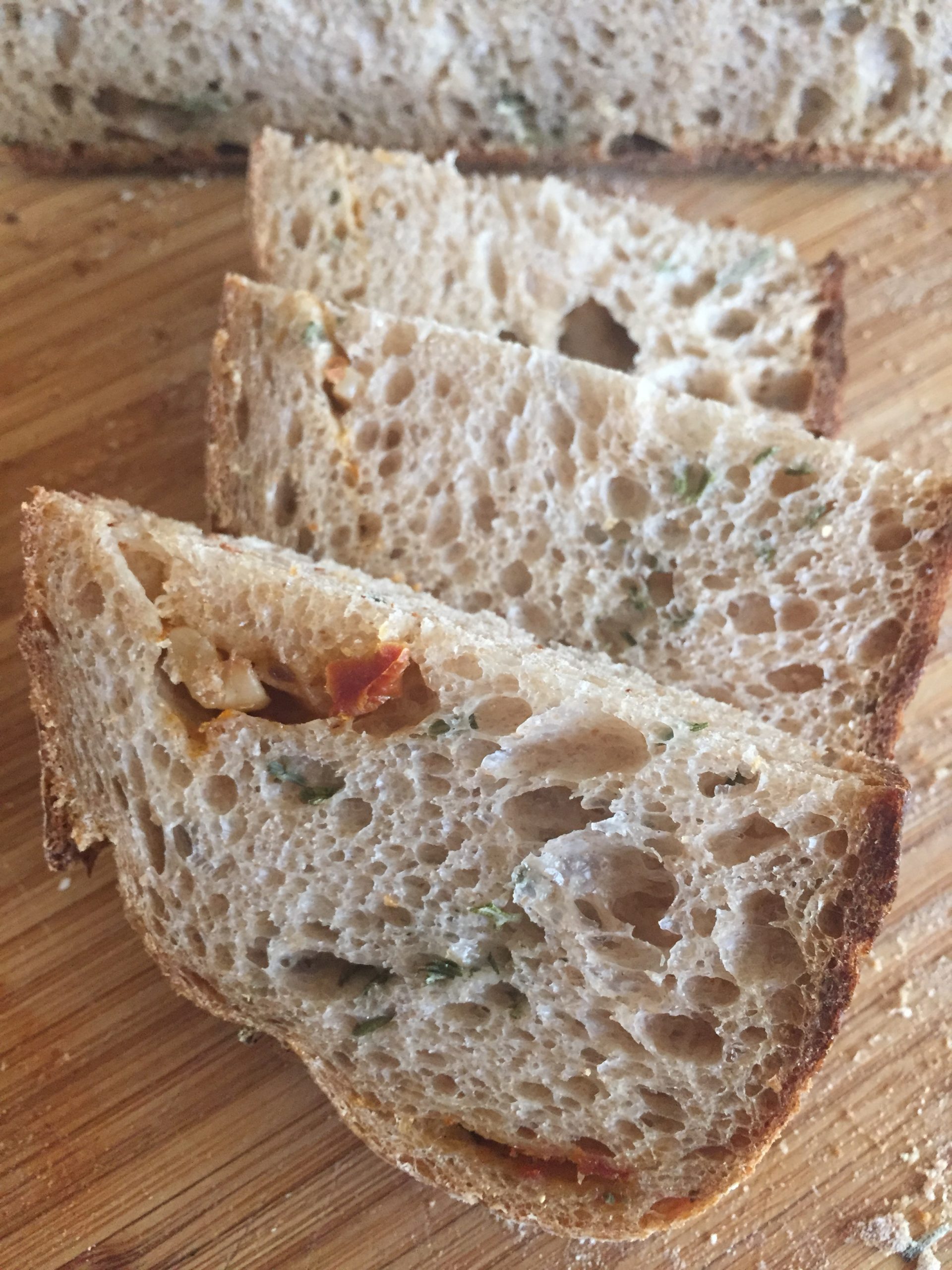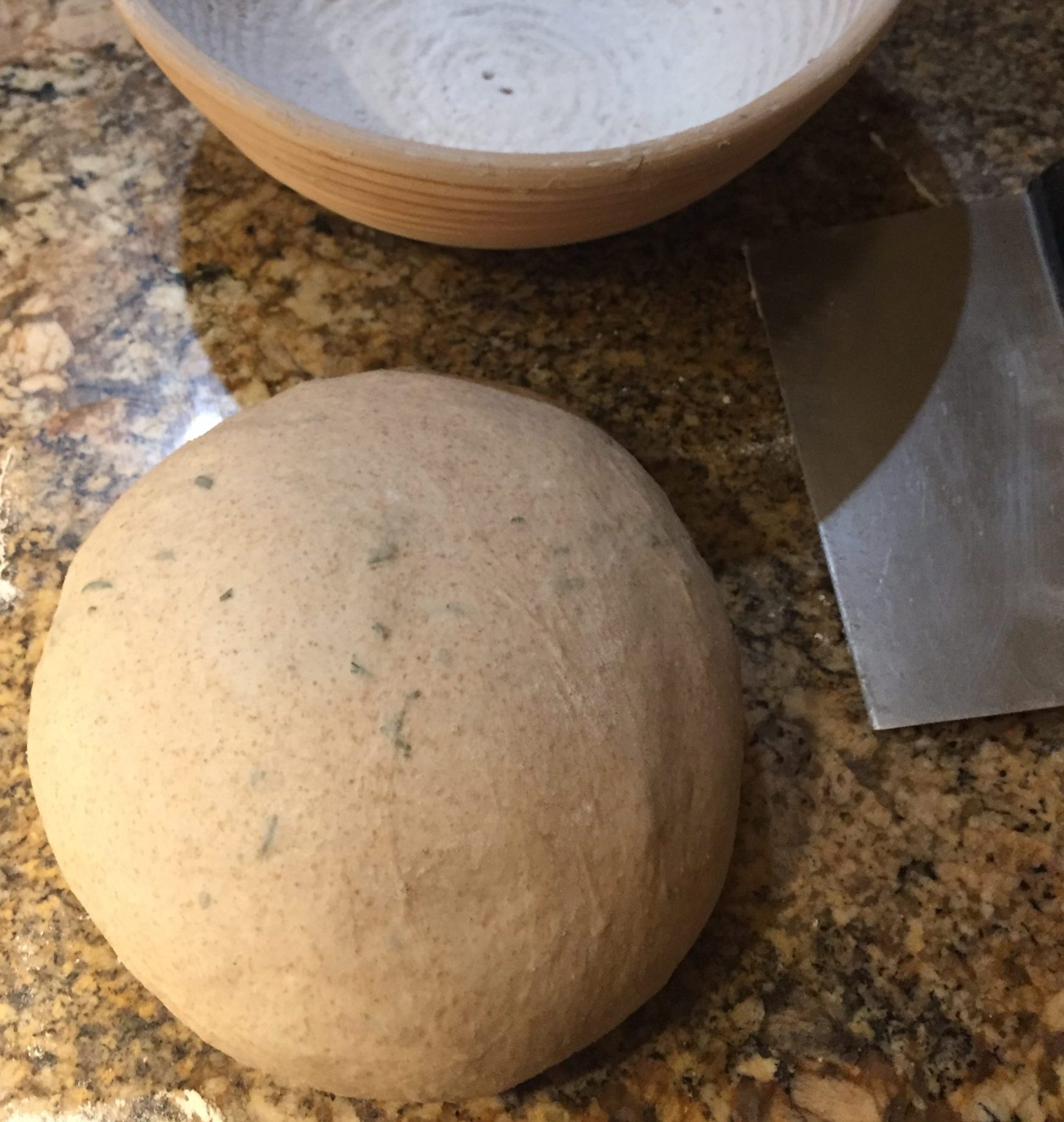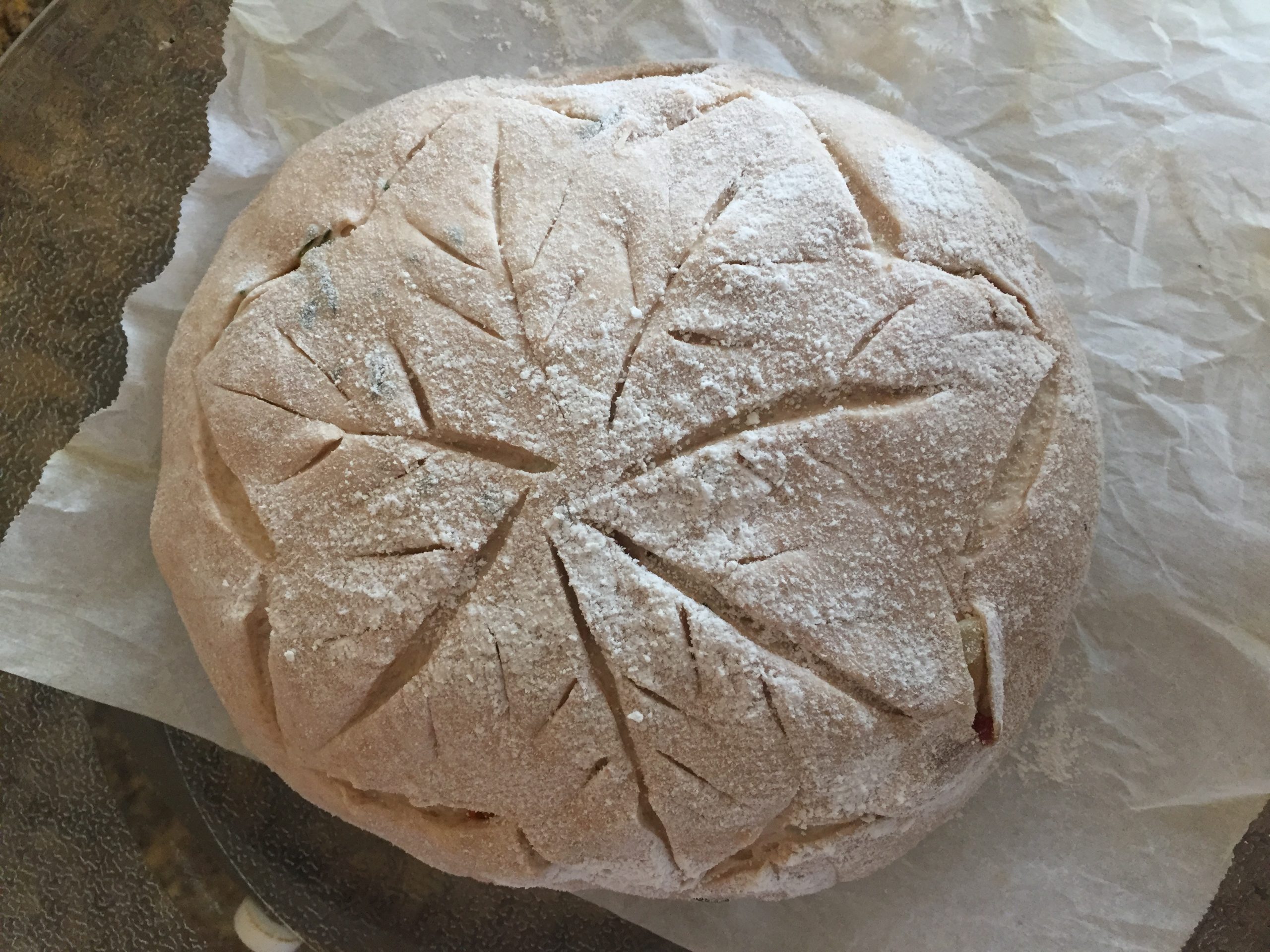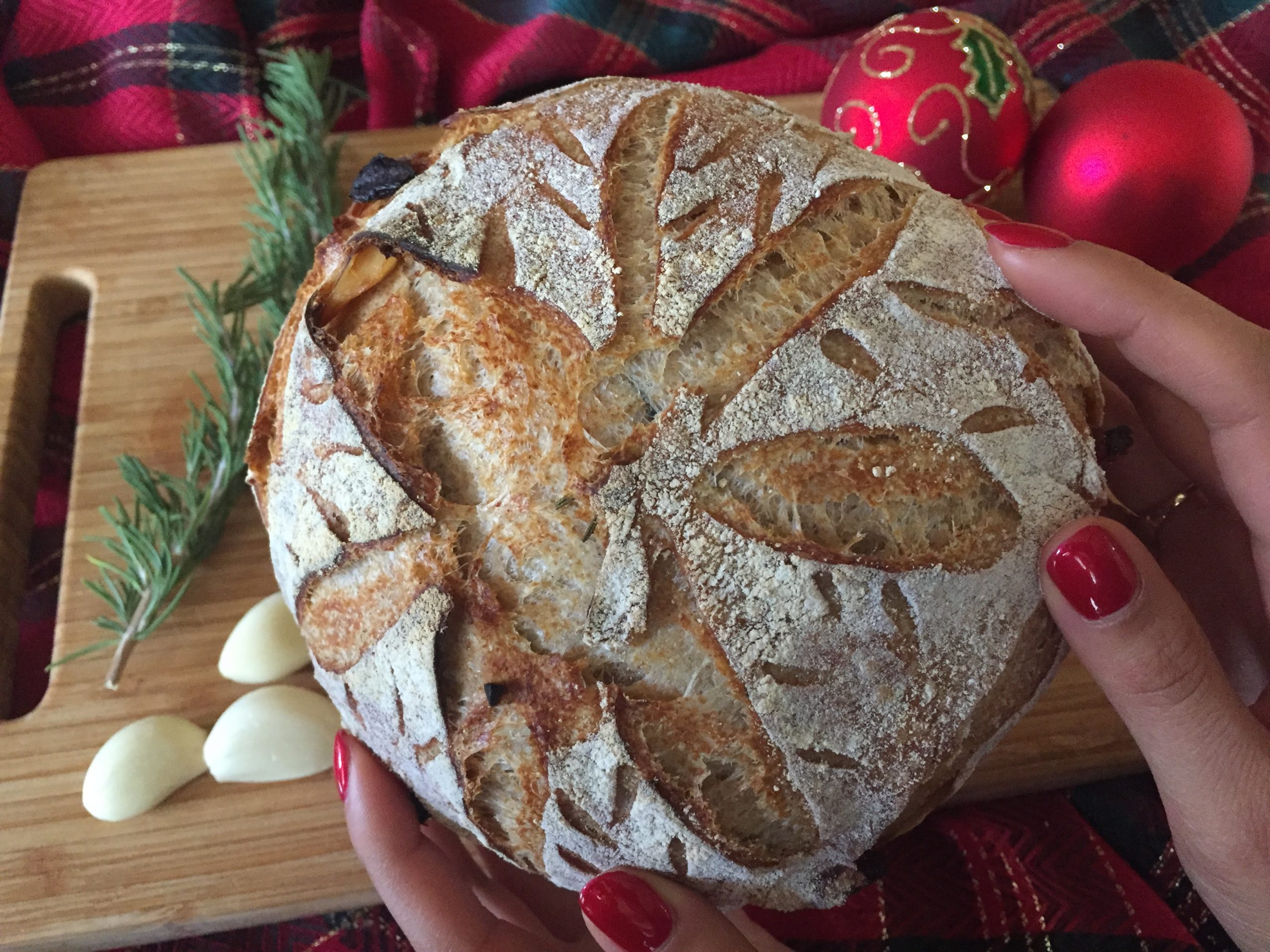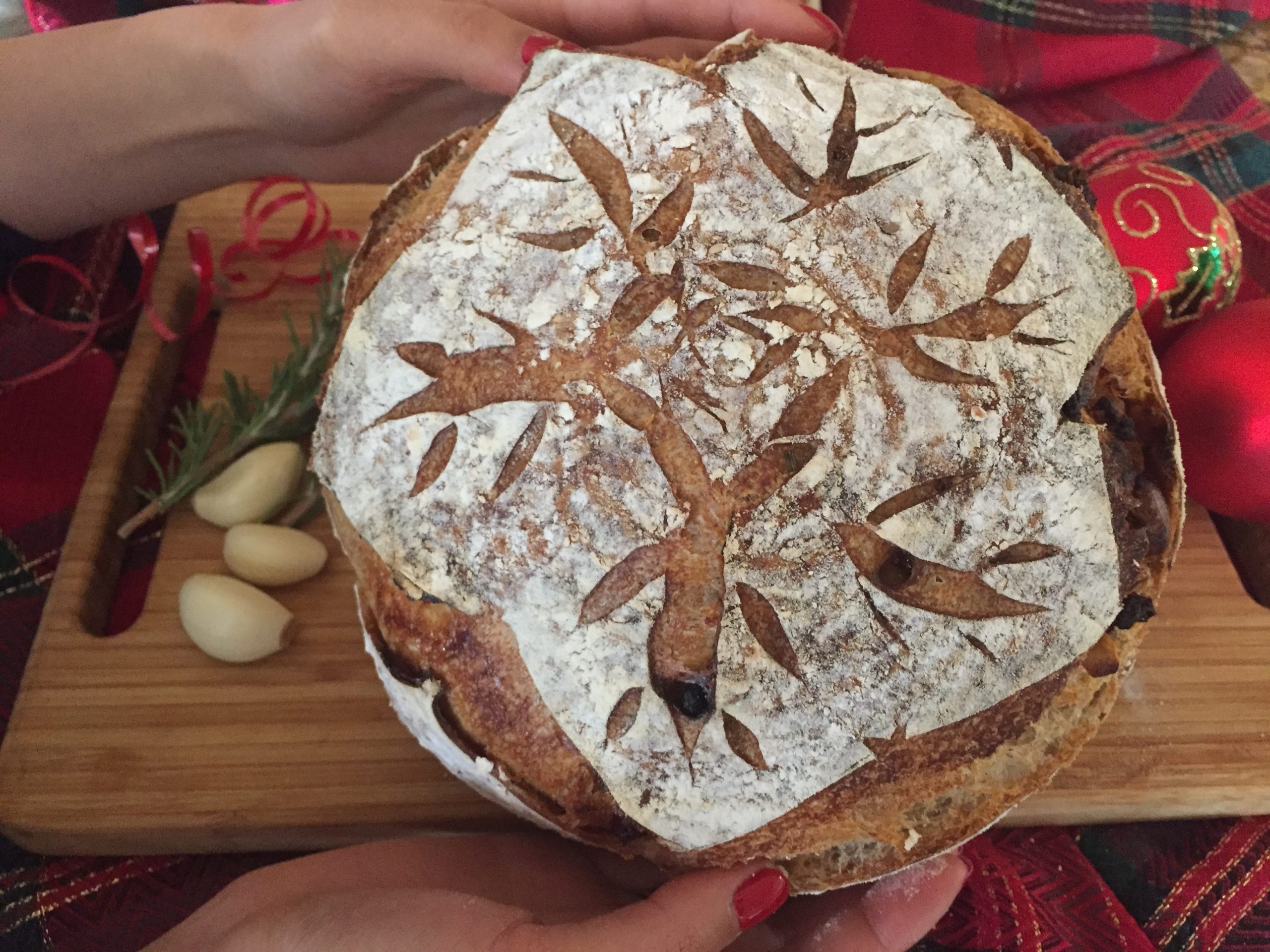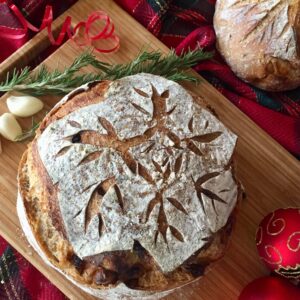0 Comments
share this
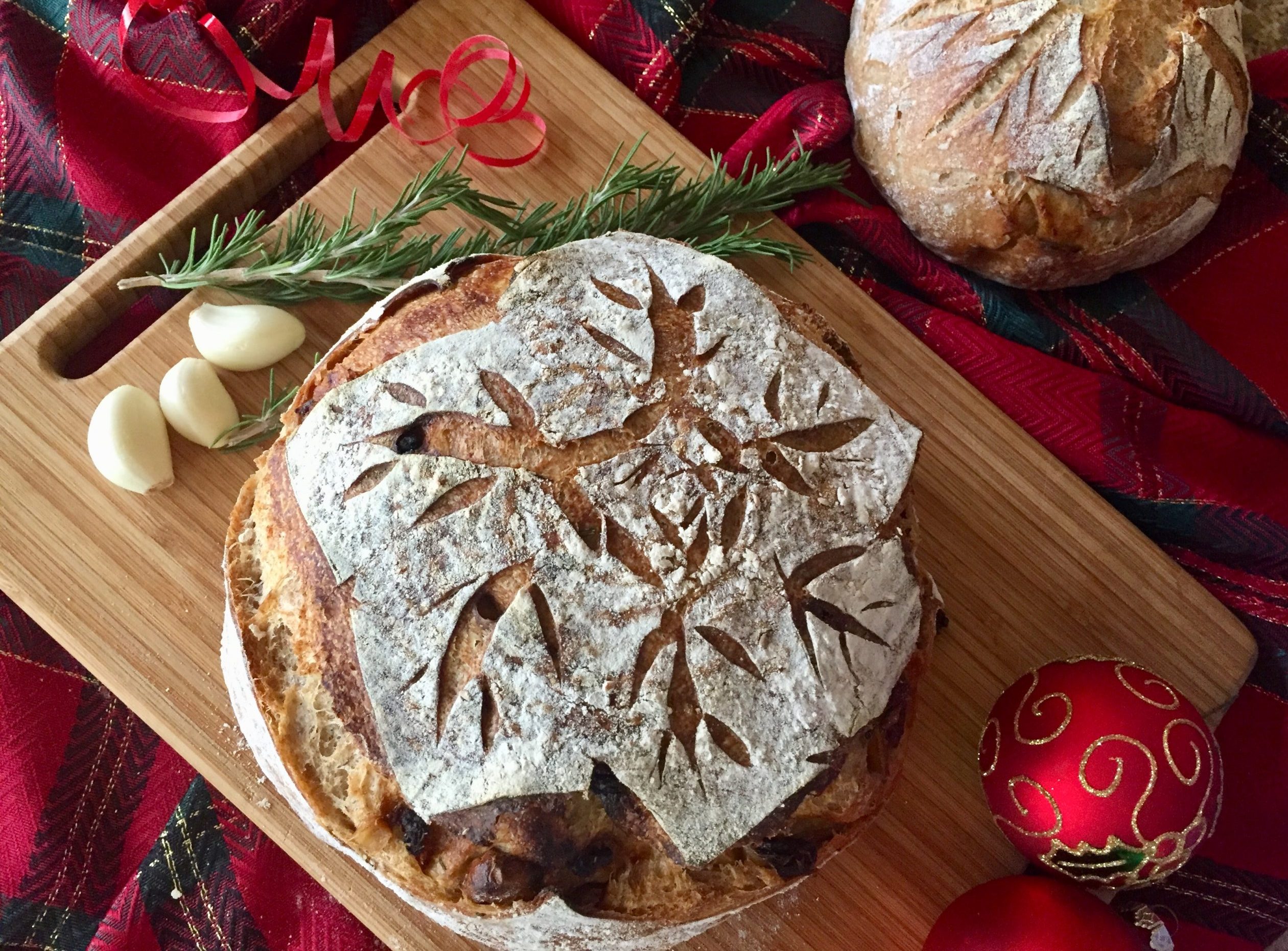
There have been many silver linings during this pandemic for me. Several very special friendships blossomed through purely virtual interactions in a Zoom barre/yoga workout group that I joined earlier this spring with my daughter. A friend from this group, who is based in San Diego and I've yet to meet in person, shared ideas for sourdough bread flavors that her daughter has been experimenting with. One of her suggestions was a sundried tomato and roasted garlic bread. Every week since April, this exercise group has been sharing stories and swapping suggestions for books, Netflix films, DIY crafts, and recipes. Had it not been for The Virus, this wonderful circle of friends would not have come together.
I was inspired by my friend's sourdough suggestion and played around with it to create a festive holiday bread with green and red elements coming from the rosemary (one could also use green olives) and tasty sundried tomatoes. The delicious bold notes of this bread transport me to a farm in the Tuscany countryside that my family stayed at during one of our trips to Italy. Our villa was surrounded by gently sloping rows of grapevines. The elderly couple that owned the farm prepared dinner for us each evening and to this day, my daughters remember "Massimo's garlic toast". The husband would take slices of stale sourdough and scrub them with fresh garlic cloves and sprigs of rosemary before pan frying them in a generous pool of olive oil.
I increased the whole wheat flour content in this recipe. I also changed the technique to allow the sourdough to extract much of the micro-organisms in the wheat germ for maximum nutrition.
It's important to know when to add the various inclusions since this recipe has rosemary, garlic and sundried tomatoes as "inclusions",
Tips.
Adding Inclusions.
Rosemary.
Since you want your fresh, chopped rosemary to be uniformly distributed throughout the bread, it is best to add it during the stretch and fold process. This allows the rosemary enough time to be fully incorporated into the dough. However, add this before the third stretch and fold, because you want the dough to build strength first before you add these herbs. Adding it too early will break some of the dough structure, resulting in a bread that may not rise well. Adding it at the end will result in a swirl of rosemary which may look good but would really be a mouthful of rosemary!
Garlic.
You can add the rosemary before the third stretch and fold or during pre-shaping. I like using roasted whole garlic cloves that I then slice. This results in occasional morsels of surprises when eating a slice of this bread. Estimate about half a bulb of garlic per loaf.
Sundried tomatoes.
Sundried tomatoes can be made. However, they are easily available in the stores either marinated in olive oil or dehydrated. Just look for sundried tomatoes that are bright red! Some inclusions, like the sundried tomato burn with the oven's high heat. As a result, it is best to only add the tomatoes at the end when you are doing the pre shaping so that all the tomatoes are nestled in the dough. However, this does not guarantee that some of these tomatoes may pop out when oven spring occurs, but will minimize the amount of sundried tomatoes being exposed.
Let me know what you think about this sundried tomato, rosemary & roasted garlic sourdough in the comment section.
HOLIDAY SUNDRIED TOMATO, ROSEMARY & ROASTED GARLIC SOURDOUGH
Equipment
- Cast Iron dutch oven
- 2 Large Bowls
- Bread lame, razor or pair of scissors
- Dish towel to cover dough
Ingredients
- 370 grams water (80 degrees-lukewarm)
- 20 grams water boiling water needed for salt solution
- 350 grams bread flour
- 150 grams whole wheat flour
- 9 grams salt
- rice / bread flour mixture Used for dusting your proofing bowl / banneton
- 100 grams levain or very active starter See "What is levain and how to make it"
Inclusions
- 10 cloves fresh garlic depending on taste.
- 1 Tbsp fresh chopped rosemary depending on taste
- 25 grams sundried tomatoes
- 1 tsp olive oil
Instructions
Make your Levain
- Make your levain the night before or use VERY ACTIVE starter.
Prepare Inclusions
- Remove outer layer of half a bulb of garlic or 10 cloves of garlic
- Drizzle with olive oil.
- Wrap in foil and bake in a toaster oven at 350° fahrenheit or 177° celcius for 20 minutes.
- Slice width-wise or coarsely chop.
- Chop fresh rosemary
- Chop sundried tomatoes
Making your bread dough
- Sift you bread and wheat flour into a bowl. I do this because some bread flours are very refined and clumpy. Sifting helps remove those clumps.
- In another bowl, add your levain to your lukewarm water and stir to mix. It does not have to dissolve.
- Mix in your flour mix and let sit for 1 hour. This allows your dough to autolyze, allowing the flour to completely absorb all the liquid making it easier to work with and allow the sourdough to break down the micro-organisms in the whole wheat flour.
- Dissolve 20 grams of boiling water with the salt and let it cool during the autolyzing process.
Kneading the bread dough.
- The dough is now ready for bulk fermentation where it will develop its flavor and body! Ambient temperatures between 70-80 degrees Fahrenheit will take 3 hours for bulk fermentation
- Add the salt solution after the dough has autolyzed.
- I stretch and fold the dough by hand...very therapeutic. Using wet hands, I pull and stretch the dough out at the top and fold it back on itself, I then rotate the dough a quarter turn and do the same thing 16 times. (4 complete revolutions!)
- Let dough rest for 30 minutes. You will notice that the dough will become more pliable with time. Cover and let sit for 30 minutes. Don’t forget to set your timer! Set timer for 30 minutes
- Stretch and fold dough
- Let it rest for 30 minutes.Set timer for 30 minutes
- Stretch and fold dough
- Let dough rest for 30 minutesSet timer for 30 minutes
- Add the chopped rosemary.
- Stretch and fold dough
- Let dough rest for 30 minutesSet timer for 30 minutes
- Stretch and fold dough
- Let dough rest for 30 minutesSet timer for 30 minutes
- Stretch and fold dough
- Let dough rest for 30 minutesSet timer for 30 minutes
- Stretch and fold dough. The dough should be soft and pliable. If not, continue bulk fermentation for another 30 mins - 1 hour.
Shaping your bread dough.
- Pull dough out of the container with top side of the dough on the floured surface.
- Gently pull the outer edges of the dough, making a flat, rectangular "pizza"
- Sprinkle the chopped sundried tomatoes and roasted garlic .
- Roll the dough from the short side edge and tuck the the 2 sides (with the swirls) underneath, forming a squarish ball.
- On a floured surface, work it into a ball by pulling it towards you and rotating. It should become somewhat taut as you pull the dough, part of your goal is to remove most of the air bubbles that were created during the fermentation process. I have found that if you keep these air bubbles, your bread will be very porous with a lot of air bubbles (almost like a ciabatta). Some people like this, other people want a little more substance. See Cutting and Shaping your Dough in my Tips & Tricks section.
- Let it sit for 20 minutes. Set timer for 20 minutes
- Shape again. See Cutting and Shaping your Dough in my Tips & Tricks section.
- Prepare your banneton (Coiled rattan baskets for proofing) by generously dusting the bowl or banneton with your bread and rice flour mixture. Dust the tops of your loaves with flour and place it in a bowl or banneton with the dome side on the bottom of the banneton.
Proofing your dough - Quick Proof
- Cover your banneton with a damp cloth and let rise in a warm place for 2 hours. I usually put this in my oven with the oven light on.Proof dough for 120 minutes
- Take your dough out and preheat oven to 500° fahrenheit (260° Celcius) with your cast iron dutch oven in it. (Should take about an hour depending to get your cast iron pot to the desired temperature.) This will be a total of 3 hours of proofing. I have proofed bread for 4 hours. However, overproofing your dough with cause your dough to lose its ability to have enough strength for the "oven-spring" (the last rise in the oven as a result of intense heat).
Proofing your dough - Slow Proof for maximum nutrition.
- Allow dough to proof at room temperature for one hour before cold proofing.
- Place your banneton in a plastic bag. Seal it with a clip. Place it in the refrigerator for 12-16 hours.
- Preheat oven to 500° fahrenheit (260° Celcius) with your cast iron dutch oven in it. (Should take about an hour depending to get your cast iron pot to the desired temperature.
Scoring your dough.
- The dough should be fairly firm but not impossible to handle after proofing. Take a piece of parchment paper that will generously cover the top of the bowl/banneton. Crumple it so that it folds easily in the pot. Place it over the bowl/banneton.
- Flip the banneton over. The dough is now ready for scoring
- Dust the top of the dough with a little more flour if necessary or brush off excess flour from proofing. Score the bread by cutting it with a razor blade, bread lame, or a pair of scissors. Scoring the bread allows for oven spring when the dough expands quickly during baking and gives your dough a pretty design. See Scoring your dough in my Tips & Tricks section.
- Gently lower your scored bread into the dutch oven. If you have a cast iron skillet / dutch oven set as shown on my "Helpful Tools" section. After scoring, place the dough in the skillet of the set and cover the dough with the dutch-oven section. Place it in the oven with the skillet on the bottom.
- Cover.
Baking your bread
- Reduce oven temperature to 450°F
- Bake for 25 minutes. Smaller 2 quart bolles should bake for 20 minutes.Set timer for 25 minutes for large bolle Set timer for 20 minutes for small bolle
- Remove the lid and continue baking for an additional 25 or 20 minutes respectively.Set timer for 25 minutes for large bolle Set timer for 20 minutes for small bolle
- Remove from oven and remove from dutch oven and let cool on wire rack.
- To bake the second loaf, after removing the first loaf, bring the oven temperature back to 500 degrees, wipe the dutch oven with a clean dry towel, place the dutch oven in it for 10 minutes and bake according to recipe.
- Bread should cool for at least an hour before attempting to slice into it!

